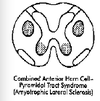Clinical Evaluation of Spinal Cord Flashcards
Myelopathy definition
Disorder resulting in spinal cord dysfunction
Nerve root definition
Combined sensory and motor rami of the spinal cord (e.g. L5)
Spinal tracts definition
Axons that travel in the spinal cord to relay information. (e.g. corticospinal tract).
Dermatome definition
Cutaneous area served by an individual sensory root.
Myotome definition
Muscles innervated by an individual motor root.
Radiculopathy definition
Sensory and/or motor dysfunction due to injury to a nerve root.
Intervertebral foramen definition
Opening formed by 2 adjacent vertebral bodies through which the nerve roots travel.
Paresthesia definition
An abnormal sensation, can include burning, pricking, tickling, or tingling
Dysesthesia definition
Impairment of sensation short of anesthesia
Hyperesthesia definition
Abnormal acuteness of sensitivity to touch, pain, or other sensory stimuli
Step-by-step approach to clinical evaluation of the spinal cord
- sx from hx and PE
- define UMN vs. LMN
- define tracts involved
- define anatomic sites involved
- differential dx
- workup
Spinothalamic tract: fxn and crossing point
- -Function: Sensory modalities of pain (pinprick) and temperature-cold/hot
- -Cross: 2-3 segments above root entry level in anterior spinal cord
Posterior/Dorsal Column: fxn and crossing point
- -Function: Sensory modalities of vibration, position, and 2-pt discrim
- -Cross: medulla (brain stem)
Corticospinal tract: fxn and crossing point
- -Function: Motor function
- -Cross: Lower medulla (brain stem)
Nerve root levels
- 8 cervical
- 12 thoracic
- 5 lumbar
- 5 sacral
- 1 coccyx
Conus medullaris level/definition
- located @~L1-L2 vertebrae where the spinal cord ends
- made up of S2-S5 spinal cord segments
Cauda equina definition
- formed by LS roots
- begins @ ~L1/L2 where the
Exit of nerve roots along spinal column
- -C1, 2, 3, 4, 5, 6, 7 roots exit above same numbered vertebra (e.g. C7 exits above C7).
- -C8 below C7 and all other roots exit below same numbered vertebra (e.g. T1 exits below T1).

Vertebral body vs. underlying cord segment @ cervical spine
- Upper cervical: vertebra # overlies same cord segment # (C2 bone, C2 cord)
- Lower cervical: vertebra # overlies cord segment # + 1 (C6 bone, C7 cord)
Vertebral body vs. underlying cord segment @ thoracic & lumbar spine
- Upper thoracic: vertebra # overlies cord segment # + 2 (T4 bone, T6 cord)
- Lower thoracic/lumbar: vertebra # overlies cord segment # +2- 3 (T 11bone, L1-2 cord)
- Lower edge of the L1 vertebral body overlies the cord tip (conus medullaris)
UMN injuries
- Corticospinal tract lesions in the spinal cord affect DTRs (deep tendon reflexes), strength, bulk, and tone in muscles AT or BELOW lesion on SAME SIDE of lesion.
- bulk: normal or disuse atrophy
- fasciculations: none
- tone: increased tone/spasticity
- DTR: hyperreflexia
- Plantar response: increased; extensor or babinski sign
DTRs of the arm and leg
- Arm: Biceps (C5, C6), Brachioradialis (C6, C7), Triceps (C6,C7), Fingers (C8).
- Leg: Quadriceps (L3, L4), Gastrocnemius (Achilles reflex, S1).
LMN injury characteristics
- bulk: decreased; significant atrophy
- fasciculations: present
- tone: decreased; flaccid
- DTRs: decreased or absent
- plantar response: decreased; flexor
Radiculopathy: sx, exam findings, localization
- “spinal root syndrome”
- Pain:
- quality is variable: “shooting,” “burning,” “tingling,” “numb.”
- often radiates into a dermatome or myotome.
- Exam: possible LMN signs (reduced or absent reflexes +/- weakness).
- Localization: determine which root the abnormal muscles(s) and dermatome(s) have in common.












